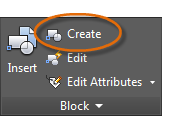Insert symbols and details into your drawings from commercial online sources or from your own designs.
In AutoCAD, a block is a collection of objects that are combined into a single named object. The following are some sample blocks at various scales.

Some of these blocks are realistic representations of objects, some are symbols, and one of them is an architectural title block for a D-size drawing.
Insert a Block
Typically, each of these blocks is an individual drawing file, perhaps saved in a folder with similar drawing files. When you need to insert one into your current drawing file, you use the INSERT command (or enter I in the Command window).

The first time you insert the drawing as a block, you need to click Browse to locate the drawing file. Make sure you organize your blocks into easy-to-find folders.

Once inserted, the block definition is stored in your current drawing. From then on, you can choose it from the Name drop-down list without needing to click the Browse button.
Notice that when you insert a block, it is attached to your cursor at the point indicated. This location is called the insertion point. By default, the insertion point is the origin point (0,0) of the original drawing.
After inserting the block, you can select it and a grip appears. You can easily move and rotate this block using this grip.

In the following example, a drawing file is inserted into the current drawing to provide a standard detail view.

Create a Block Definition
Instead of creating a drawing file to be inserted as a block, you might want to create a block definition directly in your current drawing. Use this method if you do not plan to insert the block into any other drawing. In that case, use the BLOCK command to create the block definition.

For example, this is how you could create a module for a cubicle design.
- Create the objects for the block.
- Start the BLOCK command.
- Enter a name for the block, in this case Quad-Cube.
- Select the objects that you created for the block (click 1 and 2).
- Specify the block insertion point.

You can enter the information for steps 3, 4, and 5 into the Block Definition dialog box in any order.

After creating the block definition, you can insert, copy, and rotate the block as needed.

Using the EXPLODE command, you can explode a block back to its component objects if you need to make changes. In the illustration below, the cubicle on the right was exploded and modified.

In this example, you would probably create a new block definition from the objects in the exploded block.
Recommendations
There are several different schemes for saving and retrieving block definitions.
- You can create an individual drawing file for each block that you intend to use. You save these drawing files in folders, each of which would contain a family of related drawing files.
- You can include the block definitions for title blocks and common symbols in your drawing template files to make them available immediately when starting a new drawing.
- You can create several drawing files, which are sometimes called block library drawings. Each of these drawings contains a family of related block definitions. When you insert a block library drawing into your current drawing, all the blocks that are defined in that drawing become available.